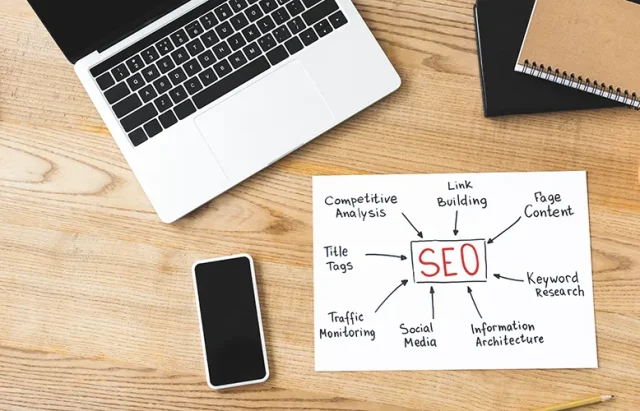
In the competitive travel market where brands compete for online visibility, search engine optimisation becomes a key differentiator in the drive for organic traffic and conversions. Websites that specialise in tourism, which because they have bigger internal content and wider product range, have to do SEO-based strategies to beat in the continuous flow of digital noise. This article also covers the four main factors that travel websites can depend upon for their success, content, strategy, analysis, and technical issues.
Search Engine Optimisation (SEO) comes out as a crucial tool for a travel website’s success and is responsible for increasing the site’s visibility in the search engine and drawing clients. Based on Search Marketing Agency A.P. Web Solutions, an optimum SEO technique is the base of a greater organic outreach plus for driving user engagement that will proactively help to boost the reservations and finally the revenue of the travel business.
URL Structure Optimisation
The URL structure of a travel website forms a network of server communication that is fundamental to the website’s SEO performance. URLs are organised in a manner that gets clear and well, search engines know the hierarchy of the website while being with good browsing. For instance, a structured URL like ‘example.com/destinations/paris’ is more informative and SEO-friendly than ‘example.com/page?id=123’.
Proper Optimisation of the URLs suggests using keyword-rich URLs, keeping them short and descriptive and also hyphenating words when necessary for readability. Through proper Optimisation of URL structure, travel sites can improve their search engine rankings and ensure their web pages are easily searchable. This on-site SEO element will make it easier for your visitors to navigate through different sections of the website.
Page Speed and User Experience
Page loading time and User Experience (UX), which can influence SEO rankings and visitor happiness, play pivotal roles in SERPs. Nowadays, many travel websites base their content on graphics that are high-definition or interactive maps. These elements can be a reason why loading times are slower if not done right. Another important feature that you must keep in mind while designing a travel website is the use of the right fonts and typography. Lately, travel & hospitality websites emphasize Dyslexia font to cater to the needs of users who have vision impairments. This is crucial to rope in additional customers and prospects who might sway away to more accessible websites. Here, a specialized company like “Accessibility Spark” can help implement such interactive and engaging elements into a travel website, keeping in mind the strict ADA WCAG compliance standards.
According to Melbourne-based SEO Agency A.P. Web Solutions, To reduce page load time and improve the UX, travel websites should be making use of image compression and lazy loading which would then facilitate the prioritisation of content. These goals can be achieved by the use of caching mechanisms to minimise the request of the server to get the data, and ensuring the sites are mobile-friendly for viewing on all devices and platforms is also one necessary step. A website that opens quickly and is easy to use is not only appreciated by search engines but also stimulates users to explore more content and finish pre-set appropriate activities such as booking flights or hospitality.
Keyword Targeting Strategy
An effective keyword targeting strategy is indispensable for travel websites to attract both commercial and informational traffic. Commercial keywords like “best hotels in Bali” or “cheap flights to New York” directly indicate purchase intent, whereas informational keywords like “travel tips for Europe” cater to users seeking valuable information.
Strategies for keyword targeting include conducting comprehensive keyword research using tools like Google Keyword Planner, creating content that aligns with targeted keywords such as destination guides, travel itineraries, and hotel reviews, and incorporating long-tail keywords and location-based terms to capture specific audience segments. Due to the scale and size of travel websites, the campaign often requires Enterprise SEO services. By strategically targeting keywords, travel websites can optimise their content for search queries and attract qualified traffic at various stages of the customer journey.
Conversion Rate Optimisation
Measuring and optimising conversion rates is imperative for travel websites seeking to maximise user engagement and bookings. Conversion Rate Optimisation (CRO) involves a comprehensive analysis of user behaviour, identification of conversion barriers, and implementation of strategic improvements to enhance overall website performance.
Key tactics for CRO in travel websites encompass various methodologies. A/B testing of landing pages and booking forms allows for data-driven decision-making, enabling the selection of designs and content that resonate best with users. Simplifying the booking process with clear calls-to-action and intuitive navigation pathways can significantly reduce friction and increase conversion rates. Moreover, personalising recommendations based on user preferences and browsing history can create a tailored experience that fosters trust and encourages bookings. Check out this Conversion Rate calculator to measure the impact that improving your travel website’s UX can have on the number of bookings it generates.
By focusing on optimising conversion rates, travel websites not only enhance user satisfaction and increase bookings but also improve their search engine rankings through elevated user engagement metrics. The symbiotic relationship between user experience and search engine visibility underscores the importance of continual refinement and adaptation within the competitive travel industry. As websites refine their CRO strategies, they not only facilitate smoother transactions but also cultivate stronger relationships with their audience, fostering loyalty and longevity in an ever-evolving digital landscape.
Case Studies and Examples
Exploring successful SEO strategies employed by prominent travel websites reveals notable achievements:
Expedia strategically optimised its URL structure and integrated schema markup to enhance visibility and attract clicks for destination-related searches, yielding a notable increase in click-through rates.
Meanwhile, Airbnb’s focus on optimising page speed through image optimisation and effective browser caching resulted in reduced bounce rates and improved rankings in mobile search results.
These case studies vividly illustrate the concrete advantages of emphasising SEO considerations within the fiercely competitive travel sector.
Tools and Resources for SEO Optimisation
Travel sites can exploit many SEO tools, including Google Search Console, SEMrush and Yoast SEO Plugin, among others. Adopting suitable tools to hone SEO strategy can put travel companies a leg up of the competition to win the indices of popularity in the fast-moving online travel industry.
Conclusion
In summary, SEO Optimisation is one of the key factors digital commerce relies on to increase online exposure, draw the target group, and get conversions. URL structure Optimisation, speed and experience of the page, strategic keyword targeting, and conversion, all these elements make up the recipe for improved search engine ranking and long-term success of travel-related businesses in the dynamic environment of the online travel industry.
Apart from generating huge organic traffic and conversions these key SEO factors will also create a brand’s reputation by assisting in sustaining the long run lasting relationship with the customers. Through the application of these SEO strategies travel websites can become well-positioned for engagement with the web users who keep investing in them thus driving growth and profitability.





